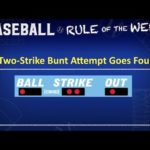6.05 Batter Out
A batter is out when –
(a) a fair or foul fly ball (other than a foul tip) is legally caught by a fielder;
A.R.— A fielder may reach into, but not step into, a dugout to make a catch, and if he/ she holds the ball, the catch shall be allowed. A fielder, in order to make a catch on a foul ball nearing a dugout or other out-of-play area (such as the stands), must have one or both feet on or over the playing surface (including the dugout) and neither foot on the ground inside the dugout or in any other out-of-play area. Ball is in play, unless the fielder, after making a legal catch, falls into a dugout or other out-of-play area, in which case the ball is dead.
(b) Majors/ Intermediate (50-70) Division/ Junior/ Senior/ Big League –
- a third strike is legally caught by the catcher;
- a third strike is not caught by the catcher when first base is occupied before two are out; Minor League and Tee Ball: A third strike is caught or not caught by the catcher. Option: A local league may elect to apply the Minor League and Tee Ball rule for the Little League (Major) Division for the regular season.
A.R.—(Majors/ Intermediate (50-70) Division/ Junior/ Senior/ Big League) When a batter becomes a runner on a third strike that is not caught, and starts for the bench or his/ her position, that batter may advance to first base at any time before entering the dugout or any other dead ball area. To put the batter out, the defense must tag the batter or first base before the batter touches first base.
(c) bunting foul on a third strike;
(d) an Infield Fly is declared;
(e) that batter attempts to hit a third strike and is touched by the ball;
(f) a fair ball touches said batter before touching a fielder;
(g) after hitting or bunting a fair ball, the bat hits the ball a second time in fair territory. The ball is dead and no runners may advance. If the batter-runner drops the bat and the ball rolls against the bat in fair territory and, in the umpire’s judgment there was no intention to interfere with the course of the ball, the ball is alive and in play;
A.R.— If a bat is thrown into fair or foul territory and interferes with a defensive player attempting to make a play, interference shall be called, whether intentional or not.
(h) after hitting or bunting a foul ball, the batter-runner intentionally deflects the course of the ball in any manner while running to first base. The ball is dead and no runners may advance;
(i) after hitting a fair ball, the batter-runner or first base is tagged before said batter-runner touches first base; or Majors/ Intermediate (50-70) Division/ Junior/ Senior/ Big League: after a third strike as defined in Rule 6.09( b), the batter-runner or first base is tagged before said batter-runner touches first base;
(j) in running the last half of the distance from home base to first base, while the ball is being fielded to first base, the batter-runner runs outside (to the right of) the three-foot line, or inside (to the left of) the foul line, and in the umpire’s judgment in so doing interferes with the fielder taking the throw at first base; except that the batter-runner may run outside (to the right of) the three-foot line or inside (to the left of) the foul line to avoid a fielder attempting to field a batted ball;
A.R.— The lines marking the three-foot lane are a part of that lane and a batter-runner is required to have both feet within the three-foot lane or on the lines marking the lane.
(k) an infielder intentionally drops a fair fly ball or line drive, with first; first and second; first and third; or first, second, and third bases occupied before two are out. The ball is dead and runner or runners shall return to their original base or bases;
A.R.— In this situation, the batter is not out if the infielder permits the ball to drop untouched to the ground, except when the Infield Fly rule applies.
(l) a preceding runner shall, in the umpire’s judgment, intentionally interfere with a fielder who is attempting to catch a thrown ball or to throw a ball in an attempt to complete a play.
(m) Intermediate (50-70) Division/ Junior/ Senior/ Big League: with two out, a runner on third base, and two strikes on the batter, the runner attempts to steal home base on a legal pitch and the ball touches the runner in the batter’s strike zone. The umpire shall call “Strike Three,” the batter is out and the run shall not count; before two are out, the umpire shall call “Strike Three,” the ball is dead, and the run counts.



